Hedgehogs are cute and funny creatures that make good pets. Many people turn them on, because they do not cause allergies and are easy to maintain. But do not expect a happy reaction from the hedgehogs when you appear at the doorstep, as is the case with cats or dogs. In this article, we will introduce you to these exotic pets and tell you how to properly care for them.
Advantages and disadvantages
Hedgehogs are small, snorting lumps covered with needles. They look very cute, do not leave anyone indifferent. Recently, these touching creatures are increasingly being brought in as pet pets in ordinary city apartments. Hurry up with a home hedgehog is not worth it. First you need to get acquainted with all the pros and cons of the content of such a small animal at home.
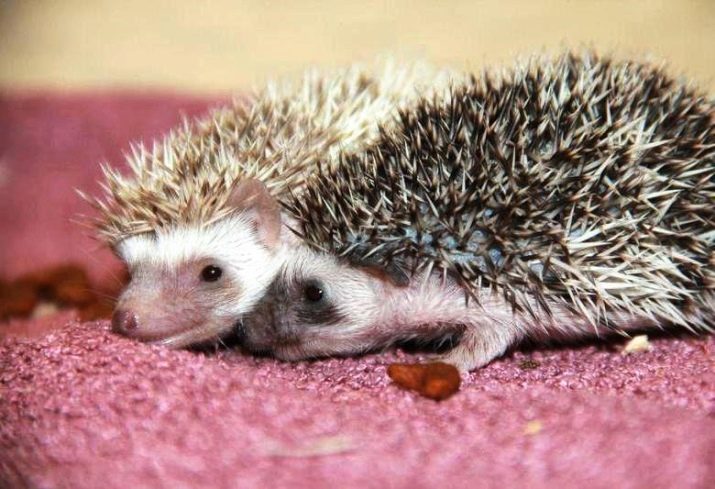
The maintenance of domestic hedgehogs implies such positive aspects.
- Few people know that in nature, the hedgehog is a predator, therefore, with its establishment, the owners can forget about various rodents and insects, since they will become the prey of a prickly animal.
- Hedgehogs are distinguished by high intelligence. They are easy to learn, and over time they begin to respond to a nickname chosen for them, like dogs or cats. Often these animals borrow some habits and behavior from other pets living in the neighborhood.
- Such a pet will not be too picky in food. Their diet may be similar to the diet of the owners. The only exception is raw meat - this is one of the main components of the menu of hedgehogs.
- Hedgehog is the best beast for people who suffer from allergic reactions. This is due to the fact that prickly pets do not have a coat of wool that causes allergies.
- Hedgehogs are not afraid of strong substances. Even if the animal finds and gets to the supplies of household chemicals in the house, there is a high probability that it will not harm him if he wants to eat it.
- Hedgehog can be an ideal pet for a person who is accustomed to a nocturnal lifestyle. For the “owls,” the prickly “neighbor” will prove to be an excellent companion, since he is a nocturnal inhabitant.
- If you take care of the pet correctly, feed it well, then it can become a real long-liver, especially compared to individuals living in nature.
- These pets do not need complicated care, especially when compared with the same cats or dogs. With a hedgehog you don’t have to go for walks, you don’t have to comb out and collect constantly falling hair.


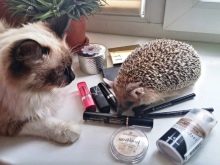
But these cute animals have enough flaws.
- Hedgehog should not be wound up by people in the house who already have other pets. This is due to the fact that hedgehogs are single and it is very difficult to find a common language with extraneous animals (even relatives). If you already have a pet at home, but you still want to get a prickly animal, then you need to make sure that they do not collide with each other.
- This pet is not suitable for families with small children. A hedgehog can leave a wound on a person’s body or even bite a child, because he really doesn’t like excess noise, sudden movements and excessive attention to his person. Even the simplest games can infuriate a pet and provoke aggression on its part.
- Hedgehogs are carriers of various infectious diseases. These include rabies, plague.
- In the "heap" of hedgehog needles, harmful parasites, such as fleas, ticks, can live. Sanitary processing can be a real test for the animal - hedgehogs carry it badly. As a result, getting rid of parasites can become too complicated.
- When the hedgehog is kept, difficulties may arise with the choice of habitat zone. If the pet just moves around the apartment, it can cause a lot of damage, and he himself will suffer. For the animal, it will be necessary to prepare a suitable cage or aviary of not the smallest dimensions. The hedgehog must freely move about its possessions. Here, the owners will have to prepare for him secluded places where the beast can hide. Such a number of nuances can deliver a lot of inconvenience to the owners.
- Hedgehog will need to bathe at least 1 time per month. But you need to know that these animals are afraid of water (although they know how to swim very well), which leads to additional difficulties - first the pet will need to be trained in it.
- As mentioned above, the hedgehog is a nocturnal beast and leads an active image with the onset of darkness, therefore, such a pet should not be wound up by people who want to sleep seamlessly at night without being afraid of extraneous noise.
- Hedgehogs, like many other animals, do not have the most pleasant smell. It will be possible to avoid such problems if you regularly clean the cage where the animal lives, use bedding made of hay or sawdust.
- Heavy smokers do not need to keep such a pet. Hedgehogs do not tolerate tobacco smoke.
- Owners need to know exactly what the breed is called to which their pet belongs, because for any of them there are specific characteristics of the habitat. An African hedgehog is best suited for apartment living, as it is not capricious, it has miniature dimensions and excellent immunity.
- Hedgehogs tolerate any damage on their body very poorly. The wounds on them heal for a long time, because of which the animals often get sick. Hedgehogs are also prone to various eye diseases.
- Like any pet, the hedgehog will need to be vaccinated in a timely manner, so it will not be possible to do without visits to the veterinarian.



Kinds
There are several types of hedgehogs that can be kept in residential conditions. Get to know them better.
African
Hedgehogs of this species are divided into the following varieties:
- Algerian;
- white-bellied;
- Somali;
- South African
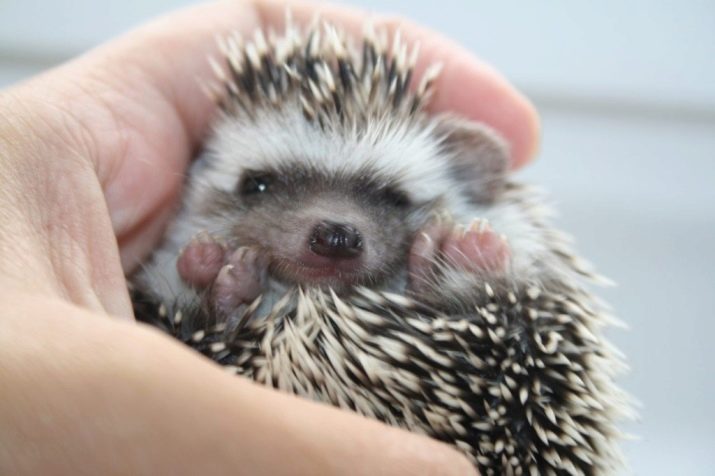
These decorative dwarf hedgehogs are not found in wildlife - they were bred artificially. Outwardly, they have much in common with ordinary hedgehogs, but have more modest sizes. When this little animal is in a good mood and absolutely calm, its needles cease to be sharp - they become soft, not short-witted.
These pets have a soft fur on the earlobe and tummy. They have a short tail and tiny clawed legs.
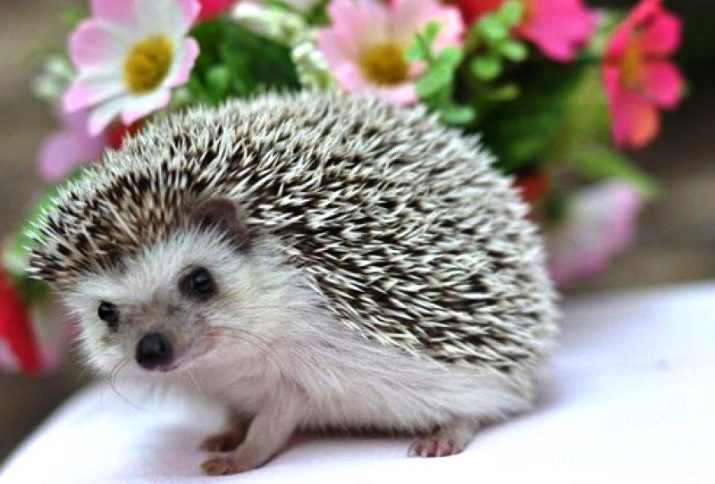
One of the differences between the African hedgehog and the forest one is that he hardly stomps when moving around the house. This animal can easily be trained to stay awake during the day, and not at night. You can distinguish an African from a simple forest inhabitant simply by looking at him - these hedgehogs are much smaller.
Among African hedgehogs there are also albinos. This is a small white animal with red eyes. These animals look very exotic.
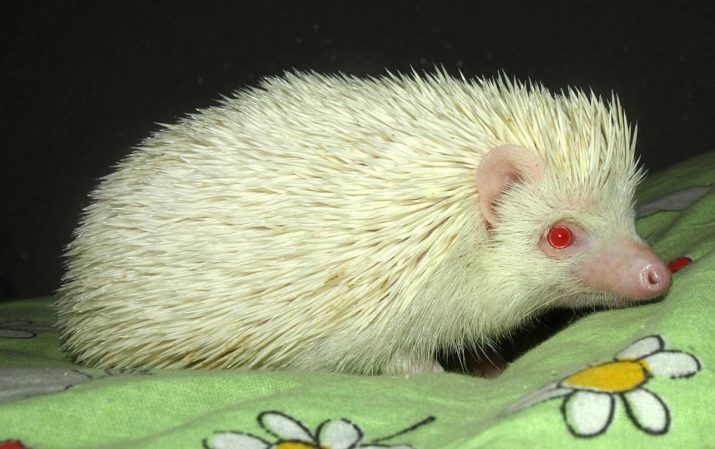
Steppe
Big lovers of high temperatures are the steppe hedgehogs. But these animals do not like high levels of humidity. They are divided into such breeds:
- Daurian;
- Chinese


Eurasian
Animals of this species are divided into such breeds:
- Amur;
- Eastern European
- European.



Eurasian hedgehogs are well prepared for the Russian climate.
Is it possible to tame a wild hedgehog?
People who want to have a hedgehog at home are wondering: is it possible to tame a wild animal? Make it real, but you need to act carefully. Many summer residents feed animals that have made their way to their plots in the country. As a result, animals get used to the person and they can be accustomed to the house.
But we must not forget that there is a risk to pick up a beast sick with rabies. Hedgehogs also suffer from lichen, salmonellosis and other serious diseases.
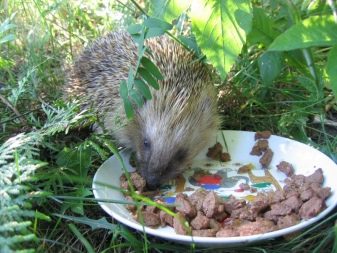

Experts say that Hedgehogs feel better in a house or apartment if they were originally born in captivity and from domesticated individuals. It is better to buy a prickly pet in a specialized store. So you will be confident in the health of the taken animal.
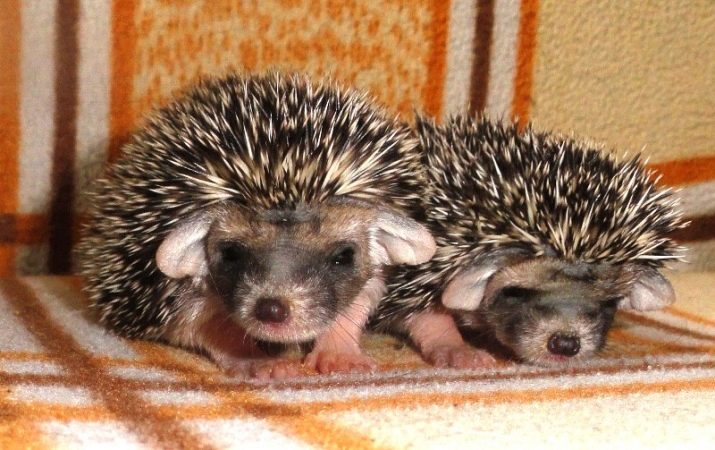
How to bathe?
If you plan to keep the pet in question at home, you should know how to properly wash it. This should be done 1-2 times a month, in warm water (not higher than 34–35 degrees). Due to this procedure, dirt is cleared from the needles, sebum. If you are in good contact with your pet, it will be easy to bathe him.
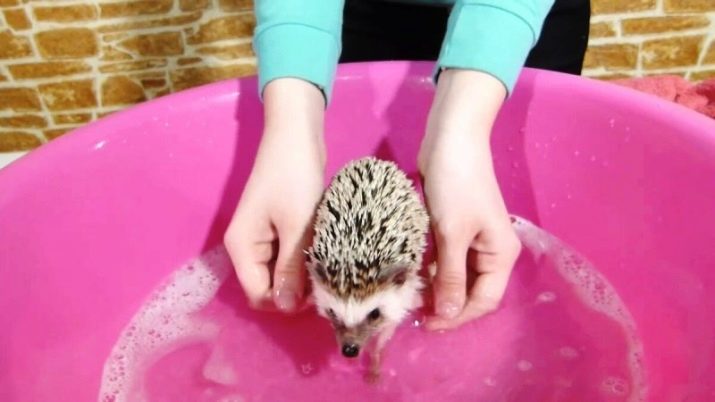
Water must be poured into the basin to the level of the lower edges of the needles so that the animal can touch the bottom of the tank with its paws. First you need to wet the back of the pet. Water should not get into the ears or muzzle. Needles are best brushed with a toothbrush. The bristles should be soft. Moving when cleaning needles follows from the head to the end of the body. It is advisable to use baby shampoo without perfumes. It is not recommended to wash the detergent under a water stream. It’s easier to put a hedgehog on your palm and pour over it.
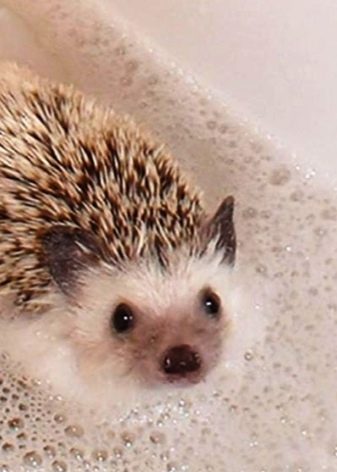

After completing all the procedures, the animal must be wiped, and the skin moistened with coconut, olive or apricot oil. It must be applied with points to the back, butt and withers. Enough of a couple of droplets.
After swimming, it’s best to do clipping the claws of the animal. It is after the bath procedures that they become much softer and it will be easier to cut them. But the procedure should be carried out as carefully and carefully as possible so as not to harm the pet, not to cause pain.
What to feed?
The diet of the home hedgehog must be organized correctly. In the natural environment, these animals feed on worms, bugs, rodents and midges. At home, pets should be offered the following foods:
- low-fat meat (beef, veal, chicken, turkey) in boiled or raw form;
- offal;
- fish;
- live insects;
- bread;
- pasta;
- cereals;
- dairy products - cottage cheese, kefir, fermented baked milk, milk;
- insects - Madagascar cockroaches, crickets (available for sale at the pet store);
- carrot-cracker mixture (it is prepared from carrots chopped on a grater, egg powder, finely chopped chicken eggs, a handful of crushed white crackers).


How to equip a home?
Housing for a home hedgehog must be equipped according to all the rules.
- The cage for the pet must be installed in a separate, quiet place, away from heating appliances, drafts and sunlight. The ideal temperature in this zone is + 22–26 degrees. With lower values, the animal will go into hibernation, and with large values it may overheat. If the heating is turned off in the spring, the cell can be covered with a blanket on top.
- Aviary must be spacious. The optimum size is 76x76 cm. It is not recommended to plant a hedgehog in a cage with metal rods - animals often and easily run away from such dwellings. The door of the house should be tightly closed.
- In the house there should be a drinking bowl, a toilet seat, a play area and a relaxation area. The sleeping area should be darkened.
- It is better to cover the floor with sawdust, which will need to be regularly changed.
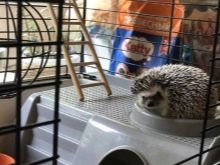
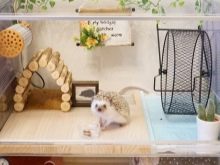
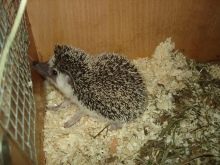
How to walk?
Domestic hedgehogs need enough space so that they can run freely, but they should not go for a walk with a harness, like with cats or dogs. If you live in a private house, it is better to equip an aviary in the yard for the animal. In the apartment for the installation of a walking aviary, it is permissible to allocate a balcony or a loggia. The height of the structures should be greater than the size of the pet standing on its hind legs (2 times).
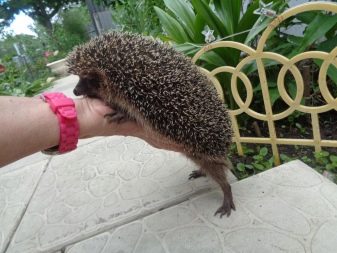
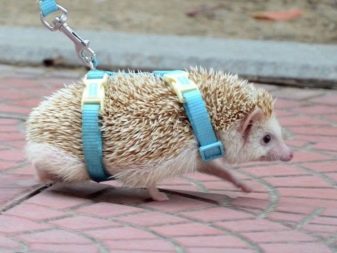
An open-air cage, standing in nature, will be more interesting to a pet if it has a lot of leaves, branches and sticks. On the balcony for a thorny friend you need to put in the corner a wheel for games and jogging, as well as a house where the animal will hide.
How many years live?
With proper care at home, a thorny friend can live 10 years. In the natural environment, hedgehogs rarely live more than 5-6 years.
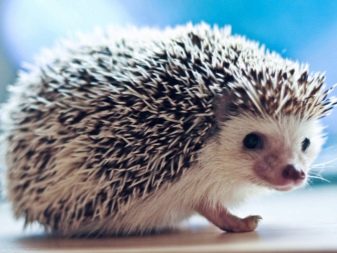

How to determine the gender?
It will be possible to determine the sex of the hedgehog when he is already over 5 days old. Previously, trying to find out the gender of the animal does not make sense - there is a great risk of mistakes. It is necessary to take the pet in his arms so that his tummy is clearly visible. It is desirable that the hind legs are set aside, and the surface of the abdomen is flat:
- if you hold the female, her genitals will be located near the anus;
- if you have a male in front of you, his genitals will be located almost in the center of the tummy (if the individual is young) or slightly lower (in adults).
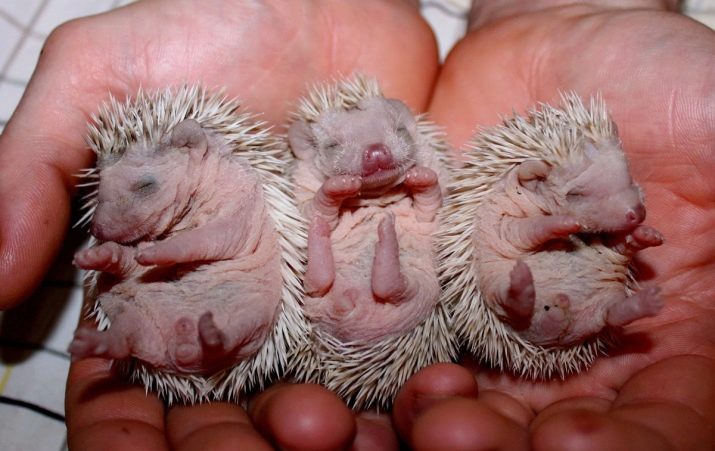
Review Owner Reviews
Many people are fascinated by the cute appearance of the hedgehogs and their small size. It's hard not to be touched by small paws, bead eyes and funny ears. People who decide to get such an exotic pet leave different reviews about him.
In the content of these interesting animals, people note such positive aspects:
- beautiful, cute appearance, it’s nice to watch a home hedgehog, which many breeders note;
- the hedgehog does not bark, does not tear furniture, it is not necessary to walk with it, as with a dog;
- most breeders did not notice the hedgehogs pungent and unpleasant odors that were expected to encounter;
- animals are easy to care for;
- do not cause allergic reactions;
- According to the owners, domestic hedgehogs in the content are quite inexpensive;
- sociable and funny animals;
- hedgehogs do not need frequent and time-consuming swimming.
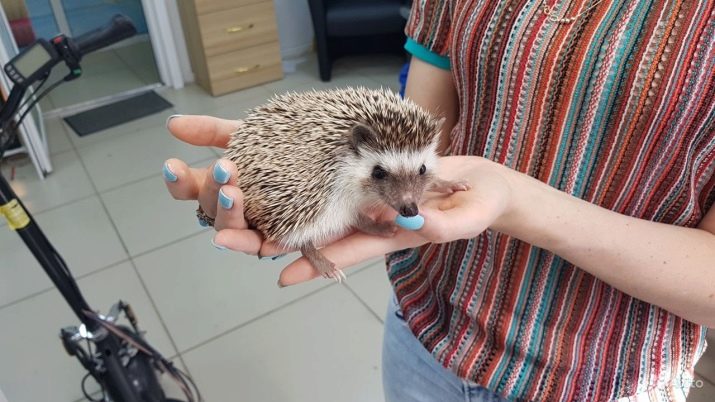
But negative reviews about the content of domestic hedgehogs are associated with such things:
- the night life of hedgehogs is annoying for most of their owners - at night the animals make noise, stomp, run in the wheel, snort and do not let them sleep peacefully;
- according to some owners who buy brand-name finished food for their hedgehogs, such food costs a tidy amount;
- at some breeders the hedgehog “sometimes pricks”;
- to the minuses, the breeders also attributed the fact that their small spiky pets often bite painfully;
- the fact that the hedgehog should be fed with insects does not like many owners;
- the owners are also upset that their pets cannot be kept in the same territory with small children and other pets.

Many of these problems can be avoided if the hedgehogs are properly maintained and the conditions under which they must live are taken into account. One must initially be prepared for the fact that this is a night animal, and during the day he will sleep more, and all his activity will begin to be shown at night. It is not necessary to buy expensive branded feed for animals - you can give them natural food, prepared on their own.
Before you get such a pet, you need to understand all the pros and cons associated with its content. It must be remembered that behind a pretty appearance and “toy” eyes, even a small but predator is hidden, which can bite and painfully prick you with its needles.

See how to look after home hedgehogs in the next video.










